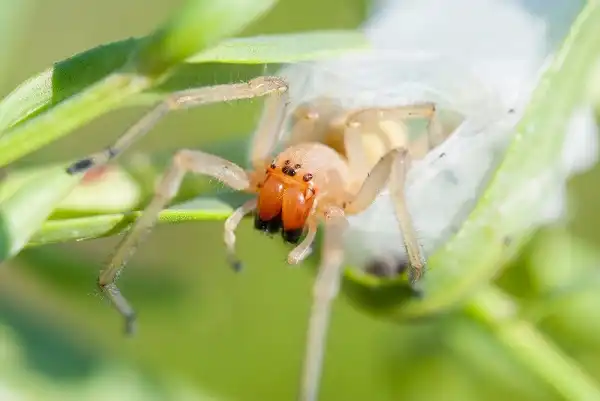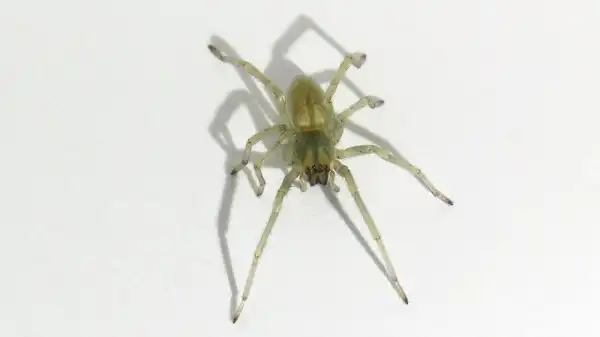Where there is warmth and light, you will likely find the yellow sac spider. With its signature yellow hue, this pest can easily be spotted in both indoor and outdoor settings across the United States. Although many people find spiders intimidating or even threatening, the truth is that most sorts of arachnids are harmless to humans. As such, it’s important to learn more about these eight-legged critters so that we can better differentiate between potentially hazardous varieties and those which should be appreciated from afar. In today’s blog post, let’s take a closer look at what makes yellow sac spiders unique — including their anatomy and behavior — while also discussing methods for preventing an infestation before it starts!

Yellow Sac Spider Description
The yellow sac spider, also known by its scientific name Cheiracanthium inclusum, is a small arachnid. As their name suggests, they are easily identifiable by their bright yellow coloring, although some individuals may appear more pale or even white in color. These spiders have eight long, slender legs which they use for both movement and capturing prey. One interesting characteristic of the yellow sac spider is that they build sac-like webs as their primary nesting and hunting location, hence they are termed “sac spiders.” The yellow sac spider has a pale yellow or light green body, with a darker stripe down the center of its cephalothorax, which is the head and thorax combined. Its legs are light yellow to pale green and have small spines. This spider has eight eyes arranged in two rows, with the front row having four small eyes and the back row having larger median eyes.
Yellow Sac Spider Habitat
The yellow sac spider has a diverse habitat and can be found in various locations throughout the United States. These arachnids prefer warm and dry environments, which is why they’re commonly found in homes, sheds, and garages. They are also known to inhabit gardens, fields, and wooded areas. Moreover, yellow sac spiders are not limited to one regional location; they have been reported in various habitats such as coastal areas, forests, and deserts. Yellow sac spiders are known to be adaptable and can thrive in a variety of environmental conditions. They have been found in regions with different types of vegetation and habitats, ranging from urban to rural areas. They typically create nests in corners, under furniture, in plants, and in wall crevices. These spiders use their silk to construct a small sac that serves as both their home and hunting ground. While these spiders prefer secluded spaces, they may end up in your home or car if you give them the opportunity to do so. They may get into your vehicle if you leave the windows open, and they can get into your home through cracks and gaps around windows, doors, and foundations.
Yellow Sac Spider Diet
The yellow sac spider is a carnivorous arachnid that feeds on a variety of insects and small arthropods. Their diet typically consists of small insects such as grasshoppers, crickets, and flies, as well as spiders and other small arachnids. They have also been known to prey on larger insects such as cockroaches and beetles. One interesting fact about the yellow sac spider’s diet is that they are known to feed on other spiders, including black widows and brown recluses. These highly venomous spiders are often avoided by other predators due to their dangerous bites, but the yellow sac spider is able to overcome their defenses with its own venomous bite. In addition to hunting live prey, yellow sac spiders are also known to scavenge for food. They will feed on dead insects and other arthropods that they come across, as well as any other organic matter that they can find.

Yellow Sac Spider Size
The yellow sac spider, also known as Cheiracanthium inclusum, is a small arachnid with a body length that ranges from 6 to 10 millimeters. The females are usually larger than the males, with their body length being up to twice the size of the males. The yellow sac spider’s small size and ability to hide and nest in tight spaces can make it difficult to detect and manage infestations. If you suspect a yellow sac spider infestation in your home or workplace, it’s important to seek the assistance of a licensed pest control professional who can safely and effectively remove the spiders. The yellow sac spider may be small in size, but it is a successful predator and a potentially harmful one.
Yellow Sac Spider Lifespan
The lifespan of a yellow sac spider is typically around 1 year, although this can vary depending on factors such as climate and food availability. Female yellow sac spiders tend to live longer than males, with some individuals surviving for up to 2 years While yellow sac spiders may be a common sight in many areas, it’s important to take precautions to prevent infestations and minimize potential harm. If you encounter a yellow sac spider or suspect an infestation, contact a pest control professional to safely and effectively manage the problem.
Yellow Sac Spider Behavior
Yellow sac spiders are known for their unique behaviors that help them survive and thrive in various environments. These spiders are active hunters, using their keen eyesight and agility to track and capture prey. They are also opportunistic scavengers, feeding on dead insects and other arthropods whenever food sources are scarce. One of the most interesting behaviors of the yellow sac spider is its ability to construct silken retreats. These retreats are usually located on plants, in cracks and crevices in buildings, or in other protected areas where the spiders can avoid predators and extreme weather conditions. Yellow sac spiders are also known for their habit of “ballooning”, which involves using their silk thread to catch the wind and float to new locations. This behavior helps the spiders to disperse to new areas and colonize new territories. While the yellow sac spider is not typically aggressive towards humans, it may bite if it feels threatened or cornered.
Yellow Sac Spider Speed
Yellow sac spiders are known to be fast and agile, making them successful hunters and effective at avoiding predators. The speed of their movements is largely attributed to their long legs, which allow them to cover ground quickly and with precision. In fact, yellow sac spiders are known to be some of the fastest spiders in the world, capable of moving at a speed of up to 1 foot per second. This fast movement allows them to quickly capture prey and also makes it difficult for predators to catch them. One interesting aspect of the yellow sac spider’s movement is its ability to move both forwards and backward with equal ease. This unique ability is due to the structure of their legs and the orientation of their joints, allowing them to move in multiple directions and maintain balance and control. Despite their impressive speed and agility, yellow sac spiders usually prefer to retreat to their silken shelters when they feel threatened or encounter potential predators. These shelters provide a safe haven where they can wait out danger and resume their activities when the coast is clear.

Yellow Sac Spider Hunting
Yellow sac spiders are active hunters that use their keen eyesight and lightning-fast movements to track and capture prey. Their speed and agility make them formidable predators, capable of catching prey in the blink of an eye. One of the key ways that yellow sac spiders hunt is by using their long legs to sense and locate prey. They can detect vibrations in the air and on surfaces, allowing them to pinpoint the location of potential prey with incredible accuracy. Once they have located their target, yellow sac spiders pounce with lightning speed, using their legs to grab and immobilize their prey. They then use their fangs to inject venom into their victim, paralyzing it and making it easier to consume.
Yellow Sac Spider Venom and Bite
Although the common house spider is generally considered harmless, there are some species of spiders that can cause serious harm if they bite. One such species is the Yellow Sac Spider, which has a toxic venom that can cause an allergic reaction or skin irritation in humans. Since yellow sac spider bites and their associated symptoms are not always immediately apparent, it is important to seek medical attention as soon as possible after any suspected spider bite. Treatment for a yellow sac spider bite typically involves applying a cold compress to reduce inflammation, applying antibiotic ointment to prevent infection, and taking over-the-counter antihistamines or pain relievers for any symptoms related to the bite. If severe allergic reactions occur or if symptoms persist after initial treatment, then medical professionals may recommend additional treatments such as intravenous fluids or antibiotics. It is also important to remember that yellow sac spiders can be found in a variety of habitats, so it is important to properly identify any potential spider before attempting to remove it from your home.
Yellow Sac Spider Reproduction
Yellow Sac spiders reproduce through a process known as courtship. During this process, the male spider will approach the female and perform an elaborate dance to show off his physical strength and agility. If successful in winning her favor, he will then insert a sperm sac into her body which she can use to fertilize her eggs when ready. Once fertilized, the female spider will lay approximately 40-50 eggs within a silk-lined egg sac that she attaches to nearby surfaces such as leaves or walls. After hatching, many of the young spiders disperse from their mother’s territories and find their own homes where they may live for up to 2 years before moving on.

Conclusion
Yellow sac spiders are fascinating creatures with a range of adaptations that allow them to survive and thrive in various environments. Their long legs and impressive speed make them proficient hunters, while their ability to construct silken shelters and balloons to new locations ensures their survival and success as a species. Although yellow sac spiders can be dangerous if threatened, they are an important part of the natural ecosystem and should be respected for the incredible abilities they possess.
Frequently Asked Question

